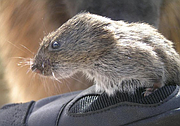Critters of North Idaho: Ye ol’ vole
If you see a little rodent scurrying about in the thicket or under the snow, you may think it’s a mouse. And it may be a mouse, but at first glance it is very difficult to tell a mouse apart from another little rodent, the vole. So difficult, in fact, that voles are often mistakenly referred to as “field mice.” What makes these little scurriers so different from each other? For starters, they belong to different families.
Mickey Mouse’s wild cousins belong to the muridae family, a group that also includes gerbils and Old World mice (i.e. common house mice) and rats. Muridae is the largest family of mammals, containing some 730 species!
Voles on the other hand belong to the second largest mammal family, cricetidae, which contains over 600 species of New World rats and mice, hamsters and lemmings.
Voles are smaller than mice. They have stockier legs and a shorter tail, and you will notice that their ears are smaller, if visible at all. Their bodybuild helps them move through the ground with ease as they excavate burrows.
There are several different species of voles native to North Idaho. Species include the montane vole (Microtus montanus), the water vole (Microtus richardsoni), and the southern red-backed vole (Myodes gapperi). The most common and widespread vole species both in North Idaho and across North America as a whole is the meadow vole (Microtus pennsylvanicus, pictured with this article).
Meadow voles usually get 5 to 8 inches long and are covered in dense brown or gray fur, sometimes peppered with red and black. As their name suggests, you are most likely to come across these tiny mammals in open grassy areas, especially where the overhead vegetation provides sufficient hiding places from predators.
They are also a common occurrence in agricultural fields, which provide them with shelter and, much to the chagrin of farmers, lots of food. Voles have been known to scavenge dead and decaying animals, but they’re technically classified as herbivores, eating seeds, grains, leaves, roots, tubers, bark, wood, fruit and even fungi.
Though they can live to be 2.5 years old in captivity, a fortunate wild meadow vole can only expect to live two or three months (though 16-month-old wild meadow voles have been reported). Life is tough when you’re a bite-sized morsel for just about any predator. Snakes, coyotes, bobcats, hawks, owls, foxes and northern-short-tailed shrews are the usual predators voles must look out for, but they’re also liable to be gobbled up by any black or brown bear, wolf, fisher, skunk, shrike or gull that happens by.
If they see a predator in time, they must dart to the nearest burrow for safety, which can be either slightly below ground or above ground in the form of a tunnel made from vegetation.
Voles don’t stop their lifestyle to hibernate, like some other rodents are in the habit of doing, and remain active all winter. They take full advantage of the winter season by digging tunnels through the snow covering the ground so they can get from one place to another out of sight from predators (this can occasionally backfire; predators like owls and foxes can hear the voles moving under the snow and attack before the vole even realizes it’s being hunted).
Much like mice, meadow voles reproduce abundantly with the little time they have on this earth. While breeding is most frequent in the spring and fall, they don’t have a specific breeding season and can reproduce all year long. If they live long enough, they can usually produce a litter of four to six offspring (they can have as many as 11 at one time) every three weeks. The young are born after a gestation period of around three weeks, weaned in two weeks and ready to have a family of their own in a month or so.
Next time you celebrate your birthday, Mother’s Day, Father’s Day or any annual holiday, spare a thought for the vole. These little guys truly do live fast and die young.
•••
Email Christian at: animaladventures1314@gmail.com



